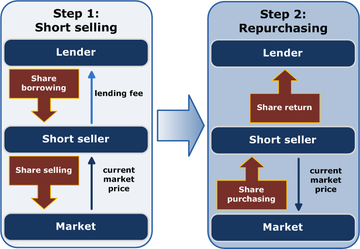
Short selling or "shorting" is the practice of selling a financial instrument that the seller does not own at the time of the sale. If you sell a stock you don't own, you are selling short.Short selling is done with the intent of later purchasing the financial instrument at a lower price. Short-sellers attempt to profit from an expected decline in the price of a financial instrument.
Short selling allows investors to profit from falling stock prices. "Buy low, sell high" is the goal . A short sale reverses the order of a typical stock purchase: the stock is sold first and bought later.
Short selling is a marginable transaction. One needs to open a margin account to sell short. This is the same account you would use if you want to use your stocks as collateral margin to trade in the markets.When you open a margin account, you must sign an agreement with your broker. This agreement says you will maintain a cash margin or pledge your stocks as margin.
Short selling is not complex, but it's a concept that many investors have trouble understanding. But Shorting is very, very risky. The mechanics behind a short sale result in some unique risks.
- Short selling is a gamble
- Losses can be infinite
- Shorting stocks involves using borrowed money(Margin Trading)
- Short squeezes can wring the profit out of your investment
- Even if you're right, it could be at the wrong time.
The two primary reasons for selling short are opportunism and portfolio protection. A short sale provides the opportunity to profit from the overpriced stock. Short sales are also used to protect an investor's portfolio against a market downturn. It protects portfolios against erosion due to a broad market decline. Short selling is essential for proper functioning of the stock market as it provides essential liquidity which in turn leads to proper price discovey.










No comments:
Post a Comment